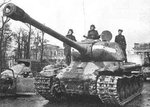the De-Marre formula assumes solid AP-shots without cap for a very narrow range of T/D ratios and obliquities.
You are right,and my supplement is that: T/D ratio should be around 1.0, it can be 1.2 while De Marre's result is still quite accurate. The hitting velocity should be less than 1200m/s otherwise both amor and projectile will fall to pieces and the remain part of projectile will continue to penetrate the amor other than "throwing back". That's why modern APFSDS is more effective than WWII AP when facing slope amor.
There is another important concept: When a projectile double its KE, it just can NOT penetrate twice thickness of same quality amor. That is to say, ONE 200mm plate's stopping power is quite bigger than TWO 100mm plates in spite of what type the projectile is (AP,APCBC, APCR etc.)With regard to multi-layer amors, we can't add up each amor's thickness simply in order to get the total stopping power.It's a basic knowledge.
Kwk43's APCBC KE has 67% advantage on kwk36's, therefore, kwk43's penetration must be LESS than 200mm@100m since 120*167%=200.
Delcyros, I agree that if kwk43 apcbc's penetration is 200mm@100m, the target plate of kwk43 must be different from kwk36's.
I've got the answer! The thick target plates (>150mm even >200mm) are of inferior quality compared to thin plates(<150mm), therefore, those mighty guns' (such as 17 pdr,kwk43 ...)score is overvalued inevitably. This can perfectly explain why those guns are not sufficient when facing Panther D's glacis (80-85mm/55 degree) which is equivalent to "good-quality thick plate"(>150mm).
LOL





